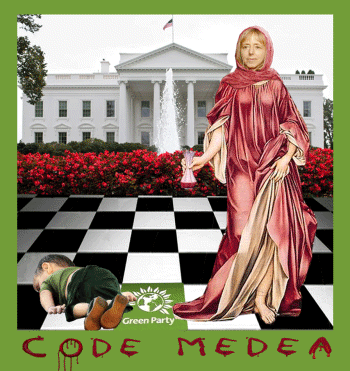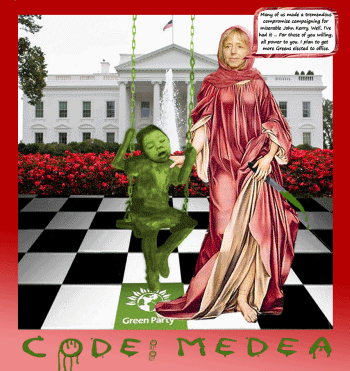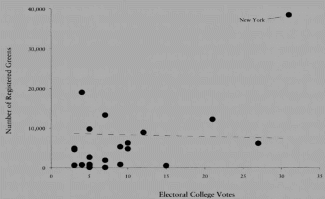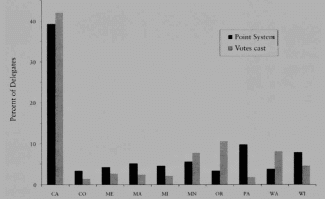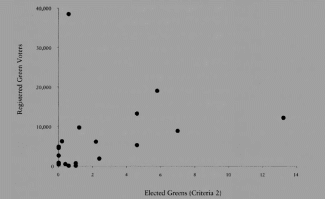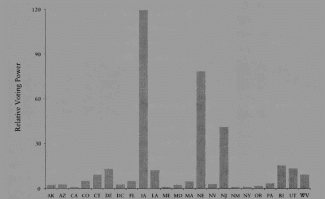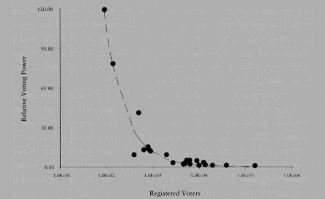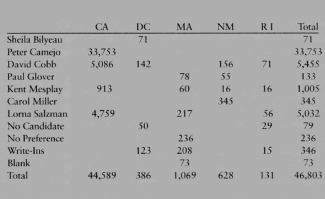CHAPTER FIVE
Lessons from the 2004 Elections Political Independence Is the Lesson of 2004 for Progressives
By Howie Hawkins
November 8, 2004
The 2004 election should jolt progressives into rejecting once and for all the self-defeating strategy of supporting the Democrats as the lesser evil. "Anybody But Bush" resulted in anything but the progressive agenda.
Progressives didn't lose on November 2. They lost long before November 2 when beating Bush became the central priority for most progressives. If Kerry had won, he would be sitting down right now with Bush during the transition period, two Skull and Bones brothers jointly planning escalation of the war in Iraq and the corresponding neglect of social and environmental crises. The only times prominent progressives got any widespread media coverage in this election was when they joined in the Democrats' $20 million attack on the independent antiwar, anti-corporate Nader/Camejo ticket.
Working people lost the election last April when the labor movement continued to support Kerry even after he pointedly prioritized deficit reduction and a military spending hike over social spending. By June, when Kerry reassured the Democratic Leadership Council, the organized corporate force in the Democratic Party of which he is a founding member, that "I am not a redistributionist Democrat," unions should have been in open rebellion against Kerry.
Environmentalists lost the election as soon as the leadership of the big environmental groups decided to attack rather than support the Nader/Camejo ticket. Nader/Camejo was the one ticket with both the will and potential capacity to put before the nation the urgent need for a demilitarization and solarization of the economy before the impending peak of oil and gas production and the food, heating, electrical, and other material supply lines of petro-industrial society start breaking down.
The peace movement lost the election when it collapsed into the pro-war Kerry campaign, thereby giving legitimacy to the postelection escalation of the war to colonize Iraq that we are now witnessing. Because Kerry was as pro-war as Bush, it was clear long before the vote on November 2 that the U.S. government, under Kerry or Bush, would escalate the war for oil in Iraq and cut domestic spending to pay for it.
The 99 percent Bush/Kerry vote should not be taken as a 99 percent mandate for sacrificing social needs at home to empire abroad. It's more like a 70 percent mandate. The November 5 AP/Ipsos poll showed seven in ten Americans think U.S. troops should stay until Iraq is "stabilized." But that is up 32 percent from earlier in the year, when polls showed that only a 38 percent minority, in both the May 11 CBS/New York Times poll and the September 13 Harris poll, said U.S. troops should stay until Iraq is "stabilized." That's what happens when two pro-war candidates debate who can best fight the war to "stabilize" Iraq and the peace movement supports one of them. Peace movement support for the pro-war lesser evil helped turn a pro-war minority into a pro-war majority.
Progressives who supported Anybody But Bush have to face the fact that their lesser-evil strategy suffered a crushing defeat in this election. Not only did unions and other nominally progressive political organizations blow a few hundred million dollars failing to elect Kerry; worse, progressives lost the battle of public opinion as the lesser-evil strategy took progressive demands completely out of the debate, thus enabling Kerry to join programmatically with Bush in a debate about which one of them could best promote a militaristic approach to Iraq, terrorism, the Patriot Act, and federal spending priorities.
Progressives made no demands on Kerry. They never threatened to take their votes to the progressive Nader/Camejo ticket. Progressives marginalized themselves by allowing Kerry to take their votes for granted.
The political lesson that progressives should draw from the 2004 election is that abandoning their demands to support the Democrats as the lesser evil is political suicide.
Progressives can best fight the right through their own party that can advance a real alternative to militarized corporate plunder without compromise because it is independent of the funding and influence of the corporate/military complex. So the next four years should be about:
• strengthening the Green Party as an alternative to the bipartisan consensus of the corporate-sponsored parties;
• recommitting the Greens to independent politics;
• building independent movements for peace, justice, and the environment that are oriented toward winning people over to their demands instead of merely delivering them to the Democratic Party; and
• giving those movements independent electoral expression, especially at the municipal level where the Greens can continue to win offices, begin transformation from below by exercising the considerable autonomous powers of municipalities, and demonstrate that there really is an alternative.
***
New Mexico: A Sobering Lesson for Practical Fusion
By Jack Uhrich
Green Horizon Quarterly
Fall 2004
The New Mexico Green Party made national headlines in 1994. Its candidates for governor and lieutenant governor, Roberto Mondragon and Steve Schmidt, received over 10 percent of the vote, and the favored Democrats in the race, Bruce King and Patsy Madrid, lost.
All of a sudden, seemingly coming from nowhere, the Greens were a power to be reckoned with in New Mexico politics. Over the next six years, they would become what David Cobb called a "flagship" state party of the national Green movement, looked to as a model by Green parties all over the country.
Actually, like all "overnight successes," there was a lot of unseen groundwork laid beforehand. The NM Green Party's first chairperson, Abe Gutmann, had gained 40 percent of the vote in a state legislative race in 1992, Andres Vargas received 42 percent the same year in a race for district attorney, and Steve Schmidt had helped lay the groundwork for all the Green electoral successes that were to come over the next several years with his proposed strategy of running "serious, credible, platform-based candidates and campaigns."
But today, after all that groundwork and success, the New Mexico Green Party is a shell of its former self. Its Web site doesn't appear to have been updated in almost two years. They've only elected two candidates in the last three years, and one of their elected officials, Santa Fe city council member Miguel Chavez, switched his registration from Green to Democrat in 2002. Further, the Greens' candidate for governor in 2002, who helped the party regain its ballot status, has also switched his registration to Democrat to help the Dennis Kucinich campaign, and many others in the Albuquerque area have done the same.
What Happened? What Lessons Can Be Learned?
What happened to the momentum of the New Mexico Greens? Is their fate indicative of larger issues within the Green Party nationally? Does their fate foretell problems to come in other states? What lessons can we learn from their successes and shortcomings?
Even though many independent and Democratic progressives (incorrectly) blamed the Greens for the Democrats' loss in 1994, there were also many progressives -- both inside and outside of the Democratic Party -- who were glad to see an alternative out there. In late 1995, this writer helped to pull together Green Party leaders and leaders of NM's Pro PAC (a political action committee for progressive Democrats). An informal compromise was worked out, whereby the Greens agreed not to run candidates against incumbent Democrats that we considered progressive and supportive of our platform. Essentially, New Mexico Greens were practicing what Abe Gutmann called "practical fusion," whereby, even though they didn't formally endorse some of the non-Green progressive candidates, Greens were tacitly supporting them by not running someone against them and splitting the progressive vote. And that type of principled, positive cooperation was reciprocated by progressive Democrats. Green Santa Fe city council member Cris Moore was endorsed by a key local union in his successful bid to become the first elected Green in New Mexico, Abe Gutmann was endorsed by Pro-PAC and the Sierra Club, this writer by the National Association of Social Workers, and other Greens were endorsed by key people-of-color, feminist, gay, and lesbian leaders who were active progressive Democrats. So Greens were seen as exercising their "Green clout" both ways, by helping progressive Democrats, as well as punishing conservative ones.
Change of Direction in 1996-97
Unfortunately, a number of events in late 1996 and early 1997 changed the direction of the Green Party and its strategy. First, the New Mexico Democratic leadership undercut the efforts of progressives in their own party, and blocked the Greens' attempts to run Democratic progressives like state legislator Max Coli and Carol Miller (who was still a Democratic candidate at that time) as fusion candidates on the Green Party ballot line. And in June 1997, the New Party lost its case for fusion before the U.S. Supreme Court, by a daunting 6-3 vote. Have a look at Micah Sifrey's Spoiling for a Fight: Third Party Politics in America (2002).
Just before the Supreme Court decision, in the spring of 1997, the New Mexico Green Party again made national headlines, when Carol Miller (now a Green), got 17 percent of the vote in a threeway special election for U.S. Congress. This time there was no denying the "spoiler" impact of a Green in the race. Conservative Republican Bill Redmond defeated Democrat Eric Serna by just 3 percent. Carol's 17 percent of the vote was a clear factor in Serna's defeat.
Following the exercising of the spoiler part of the party's "Green clout" in the 1997 race, even more progressive and moderate Democrats made overtures to move toward fusion, whether practical or legal. According to John Nichols, in the August 1997 issue of The Progressive magazine ("Spoiling for success: in New Mexico, the Green Party costs the Democrats a Congressional seat"), Bill Richardson, then the most prominent New Mexico Democrat, and a Latino, called for "early entreaties" to the Greens, and even talked about a Green-Democrat fusion ticket for Governor in 1998.
Also, in early 1998 Shirley Baca, a popular, progressive Chicana Democratic state legislator, approached the Greens about running as a fusion candidate for Congress in New Mexico's southern district, which had a reactionary Republican congressman. She was even willing to use her situation to put forth another test case on fusion to the New Mexico courts, which many Greens and legal experts believed they could have won.
At the same time, Greens continued to win on the local level. Fran Sena Gallegos was elected as a Santa Fe judge in March of 1996, Gary Claus was elected to the Silver City Council in May of 1997, and Cris Moore was re-elected to the Santa Fe City Council in March of 1998.
An Accumulation of High-Profile "Spoiler Races"
But the accumulation of high-profile "spoiler races" had begun to dampen the tenuous coalition the Greens had built with Roberto Mondragon and his progressive allies in the Chicano community. Roberto, a lifelong friend of Eric Serna's, who had worked together with him on the Rainbow Coalition, left the Greens and returned to Serna and the Democrats when the Greens endorsed Carol's run in 1997.
At this point the New Mexico Greens were at a crossroads. Legal fusion, at least as a national strategy, was dead. However, it was still legally possible in New Mexico, there was support for it among even some mainstream Democrats like Richardson, and, even without it, there were practical things that Greens and progressive Democrats had cooperated on up until then, and could continue to cooperate on. In other words, "practical fusion" was still possible, as both a state and a national strategy.
Carol Miller Chooses to Run for Congress Again: Party Is Split
However, at the Green Party's state convention in 1998, Carol Miller refused the urgings of a number of the elders in the party that she run for another, less volatile office, like secretary of state, where many felt she had a real chance of winning. Instead, she chose to run again for Congress, this time against popular New Mexico attorney general Tom Udall. As attorney general, Udall had protected the Greens' ballot status with a special ruling that he had issued, and he was supportive of many parts of the Green Party platform.
At that same convention, the Greens voted formally not to continue to seek fusion, but to instead push for IRV as its major electoral reform. They did stay out of the governor's race, but they refused to support Shirley Baca for Congress, or moderate Republican Lorenzo Garcia in his race for treasurer (even though he had gained the Greens their highest vote total ever in a statewide race, 33 percent, running as a Green in 1994).
Besides Miller's race, 1998 also brought two more spoiler races where the Democrats lost. Green Bob Anderson gained more than 15 percent of the vote in a special congressional election in Albuquerque in the spring of 1998, and then more than 10 percent in the general election in the fall. In both races, Anderson's percentages prevented the Democrat from winning and helped elect conservative Heather Wilson, who is now a national force in Republican politics.
In the meantime, Carol Miller received less than 4 percent in her race against Tom Udall, avoiding another Democratic loss. However, her decision to run caused a major split among Greens over the practical fusion versus the more purist spoiler/instant runoff voting (lRV) strategy. Many Greens in Carol's district and around the state had openly expressed concern about the spoiler effect of her run in the Udall race, and Abe Gutmann even went so far as to organize a "Greens for Udall" campaign. He was ultimately censured by the party for taking financial support from Udall for this effort, but his censure led to an ongoing internal struggle that ultimately split the party in two, and that continues to this day.
Movement Groups Angered by the Spoiler Campaigns
Along with that, Miller's insistence on running against Udall, coupled with the outcome of the 1998 Congressional races in Albuquerque, angered many in organized labor, the people-of-color communities, and other former allies of the Greens in the gay and lesbian, environmentalist, and women's movements. Most people agreed that the Democratic candidate in Albuquerque was particularly weak, but they also felt that the Republican, Heather Wilson, was infinitely worse. Consequently, in 1999, a coalition of progressive people-of-color groups attacked the New Mexico Greens with a public campaign that reached the national media, accusing them of being racist and not caring about working-class people.
The Greens eventually met with and worked out an uneasy truce with these groups, but the die was cast. From then on, for all intents and purposes, active alliances between the Greens and people-of-color organizations -- as well as most of organized labor and other progressive groups -- were essentially over.
In 2000, there was yet another high-level spoiler race in the Albuquerque congressional race, coupled with the impact of Ralph Nader's national race. So, in a period of six years, the Green Party of New Mexico found itself involved in six high-profile spoiler races, in addition to the Nader 2000 race. In each race, there were good reasons not to like the choices the Democrats offered. But in each case (except for the Udall race), the Republican who was elected in place of the Democratic candidate was measurably worse than the Democrat. And in the case of Udall's election, the state Green Party officially opposed him, and then punished the most prominent Green who supported him, alienating many of Udall's supporters, most of whom would have supported Greens in other races.
Democrats Shift Strategy: Wait Out the Greens, "No" To IRV
All of this set the stage for what has taken place since. Despite the Greens' continued arguments that IRV is ultimately in the Democrats' interest to support, the Democratic establishment appears to have chosen instead to wait out the Greens. They apparently believe that the Greens will eventually wear out their welcome with the people, who they think will ultimately decide that it's better to elect a bad Democrat -- than vote for a Green and see an even worse Republican elected.
And the Democrats' strategy seems to be working. At present there are only two elected Greens in office, down from a high of five in 2000.
New Mexico's experience with their own six spoiler races, combined with the impact of the 2000 presidential race, and the subsequent threat of a spoiling effect on other high-profile races, such as Paul Wellstone's U.S. Senate race in Minnesota in 2002, has left every state Green Party with a spoiler "albatross" that it must begin to address realistically. In order to implement practical reforms like instant runoff voting, Greens need to have at least a working relationship with Democrats, especially those closest to the beliefs and values of the Green Party platform. But the effects of continuous spoiler races, without an at least equal amount of counter-balancing cooperative efforts with the broader progressive community, have been to drive a wedge between the two camps.
A Different Green Strategy Is Needed
Obviously a different strategy is needed. I advocate that we return to the original New Mexico strategy of fusion, both legal fusion, where possible, and practical fusion where it isn't. That does not mean we should abandon the quest for IRV, or that we would never use the threat of spoiling a race. Practical fusion includes the threat of spoiler races, and the spoiler races in 1994 and 1997 obviously had some major positive outcomes toward building the party. Our initial judicious use of a combination of practical fusion and spoiling in the mid-1990s enabled us to come very close (one vote, in the last legislative committee) to getting IRV on the ballot as a constitutional amendment.
However, after 1997 the party became too rigid in its approach, too unwilling to accept certain political realities that they were not in a position to change at that time, and too lacking in collective knowledge about how to negotiate the Green clout they had built into practical accomplishments that they could continue to build on. Instead, the political purism of the New Mexico Greens of the late-1990s (and this author embarrassingly includes himself as all too often a part of that purist camp), led to too few wins on the local level to counterbalance the effect of the high-profile spoiler races, and a growing unwillingness on the part of new candidates to step forward and run on the Green Party line. This left the public with the perception that the Greens may have admirable values and good ideas, but don't have the knowledge or the clout to make them reality.
What If!
Looking back, one cannot help but wonder, what if, after the 1997 race, Carol Miller had instead run for secretary of state and the Greens had instead supported Udall openly, as well as Shirley Baca in her southern New Mexico congressional race (a race she could also have run with our support)? Both Democrats were basically supportive of most of the Green Party platform. What if both of them had won, with open Green support? What if, instead of running in the second election in 1998, Bob Anderson had declared the first race as essentially the first outcome of an IRV-style selection process, with him being the candidate disqualified in the first round of voting, and thrown his support to the Democratic candidate in the second race? It's possible that New Mexico would now have possibly three Democratic congresspeople, instead of just one, and two of them more progressive than most Democrats in Congress.
Would not the Green Party in New Mexico also have looked different today? When progressives saw that the Green Party used their Green clout in more than just negative ways, the Green Party wouldn't have been yoked with the spoiler albatross. Green clout would be seen as a force that could help Democrats as well as hurt them. In turn, the New Mexico Green Party today would be enjoying increased support from labor, progressive organizations, people-of-color organizations, and progressive Democrats, all grateful for the critical support of the Greens -- support that had been the key to victory in these elections. Perhaps then, Green Abe Gutmann's 45 percent vote for city council in 1997, and Melissa McDonald's 46 percent in her 2000 race for county commissioner, would have instead been stretched to a winning 51 percent, and Greens would have representation in the governments of two of the most influential counties in the state. Perhaps Tom Udall and other progressive Democrats would have been so grateful for our support that they would have continued their qualified support for the party, and we would be growing in numbers, candidates, and newly elected Greens, instead of scratching our heads as to what went wrong.
Unfortunately, members of the Green Party can't rewrite New Mexico's history. They can only learn from it, apply it to their own times, develop new strategies, and try to do better in their future work. But the history lesson of New Mexico is that it's time for a change in strategy, if the Green Party is to grow and thrive.
As we go to press, there is some indication that the climate in New Mexico is starting to change. Popular Green leader Rick Lass has decided to drop out of his race for the New Mexico state legislature, so as not to split the vote with a progressive Democrat, who has a better chance of winning, and who supports much of the Green Party platform. Perhaps once again, the New Mexico Green Party will provide a model for Green parties all over the country to look up to.
***
The Greens Are Enduring, Debating, and Learning
By Steve Welzer
Green Horizon Quarterly
Spring 2005
The Green Party has now run national electoral campaigns under conditions of Democratic Party incumbency (2000) and Republican Party incumbency (2004). There were specific circumstances and issues in each case, of course, but to the extent that general conclusions can be drawn and lessons learned from these experiences the party will benefit and go forward.
Perhaps the most significant observation is that the Green Party, running an appealing candidate, has a chance to be perceived by many progressives as a serious and welcome alternative when a Democrat has been occupying the White House, but when the incumbent administration is Republican many of those same progressives will view the candidate of the Democratic Party as enough of an alternative as to merit support; moreover, they will tend to adopt a rhetoric of "closing ranks" and harangue against "spoiling," putting pressure on the Green Party to avoid running a high-impact campaign.
Handling "Anybody But... "
The "ABB" (Anybody-But-Bush) syndrome made 2004 a difficult year for the Greens, but it was certainly instructive. What the Greens will need to do is learn to anticipate it (in its generalized form -- "ABR" -- Anybody But the Republican). If the Green Party could become the repository of memory for the electoral wing of the social change movement, it could be ready each cycle to graphically remind progressives about the extent to which they are invariably disappointed with Democrats in power -- and about how the resurgence of alarmism when the Republicans are in serves no function other than to retard the development of a true alternative.
Another lesson of 2004 is that, internally, the Greens need to develop an organizational culture of steadfast independence. It was problematic that a significant number of Greens supported, worked for, contributed to, or voted for the candidate of the Democratic Party in 2004. Others reacted to the ABB pressure by opting for a low-impact, deferential presidential campaign. If they hope to overcome third-party marginalism, the Greens will need to project an image of gravitas while establishing in the minds of the voters a strong and clear-cut differentiation between themselves and both of the establishment parties.
Handling "Spoiler" Vilification
There is no way to know whether or not AI Gore would have won the 2000 election if the Ralph Nader/Green Party ticket had not attracted the highest percentage vote for a progressive third-party campaign since that of Robert LaFollette in 1924. It is conceivable that Nader did, in fact, "spoil" the election for Gore.
What's not in doubt is that the high-visibility impact of the 2000 campaign transformed and simultaneously provoked a crisis within the Green Party. On the one hand it was a step toward the party becoming viewed as a potentially serious new force in American politics and it catapulted the Greens to the front of the ranks among third-party initiatives. On the other hand, justified or not, it prominently associated the Green Party with spoiling. Nader's role in the election became fodder for the punditry; both he and the party found themselves confronted with a stinging campaign of vilification. (Seen on a Democratic Party discussion e-list: "GREEN=Get Republicans Elected Every November.")
The "spoiling" issue is a complex and difficult one that always has divided partisans of independent politics in this country, given our winner-take-all system -- and it surely will continue to do so until thoroughgoing electoral-system reform is achieved. Groups and even individuals are torn about this issue. In recent years the Labor Party and the New Party foundered when they were not able to successfully come to terms with it. So it was not surprising to see the Green Party internally divided as the 2004 electoral cycle approached.
Some Greens were concerned that if the party was perceived to "again" be a factor in the defeat of the Democratic Party opponent to George W. Bush, an indelible "bull in a china shop" stigma would impede its organizing efforts for years to come. When Ralph Nader made it clear that he would not accede to any type of campaign strategy which involved less than an all-out effort, Greens concerned about spoiling resisted the idea of another Nader/Green campaign.
Others, to the contrary, felt it was specifically important for the Greens to show that the party would not back down in the face of the "spoiler" vilification. They asserted it would be a mistake to give any credence to the idea that the Green Party's 2.7 percent of the vote in 2000 constituted "too much of an impact," and they felt that a rejection of Nader could give the impression that the party was less than steadfast in its determination to become a serious electoral force.
Questions and Differing Perceptions about the Party's Role
Discussions leading up to 2004, while often focused on the "Nader question" showed the extent to which Greens have questions and differing perceptions about the appropriate role of their party vis-a-vis the establishment parties. Should there be any degree of contingency to our opposition? Is our growth dependent upon weaning progressives gradually out of the orbit of the Democratic Party? To what extent and under what circumstances should we take pains to be "good citizens of the progressive movement" by deferring to the fact that the Democrat is the immediate practical alternative in an important race?
These questions deeply divided the party in a year when many progressives were viewing the 2004 election as a national plebiscite on the legitimacy, policies, and war of George W. Bush. The Cobb/LaMarche campaign made a point of exhibiting understanding and tolerance for voters who felt they had to prioritize defeating Bush. This posture succeeded in getting attention and praise from those prone to advocating an "inside/outside" strategy (a July letter from progressives with that orientation toward the Democratic Party stated: "David Cobb has earned our endorsement in safe states by deftly steering the Green Party toward a nuanced strategy dedicated to ousting Bush, while seeking to grow a grassroots party ... "). Pro-Nader Greens expressed concern that such a strategy compromised the party's independence to an unacceptable degree. The debate about this fundamental issue has by no means been resolved and is sure to continue. As it becomes recognized that the issue is, indeed, complex and that both positions have some merit, the discussion may very well become less rancorous and divisive.
Important to Keep Moving Forward
In order to learn from mistakes, regroup after divisions, benefit from internal debates, build consensus, and take advantage of organizational memory, a party must endure and keep moving forward. The Greens are well aware that prior attempts to build an alternative progressive political force in this country -- Socialist, Progressive, Labor, Citizens, Rainbow -- have failed to reach critical mass, disappearing or stagnating after a few electoral cycles or, at most, a few decades.
It is encouraging that the Green Party survived the difficult circumstances it encountered in 2004. Criticisms regarding the party's pace of growth, lack of cohesion, difficulty with fundraising, etc., need to be taken to heart, but, on the other hand, the critics should acknowledge the fact that among the group of third-party startup initiatives of the 1990s, only the Green Party has shown endurance.
Working in the party's favor is the resonance of the Green politics movement worldwide. Ecological responsibility has emerged as a major theme of twenty-first century political discourse. And, to its credit, the U.S. Green Party has demonstrated a capability to take advantage of opportunity. The Nader/Green campaign of 2000 stepped into the spotlight when the Reform Party unexpectedly imploded and the Gore candidacy fizzled. In 2004 the Cobb campaign skillfully maneuvered into a position where it could spearhead the challenge to the election irregularities in Ohio. (William Rivers Pitt wrote: "The presidential candidates for the Green Party and Libertarian Party deserve the lion's share of praise and credit for the [challenge to the Ohio Electors in the U.S. Congress on Thursday, January 6th] .... Cobb and Badnarik forced the Democrats to do the right thing, and that made Thursday a banner day for third parties in America." [www.truthout.org.1/7/05])
Endurance in the Face of Crisis
So it turns out that there were some positive highlights to point to in a difficult year. It still remains to be seen whether or not the Green Party can accomplish what no other third party has been able to do in recent memory, i.e., break out of the marginal tier to gain widespread recognition as a viable oppositional force. The Greens must not allow "spoiler aversion" to hold them back. Not only is spoiling inevitable (there is no way to go from 1-4 percent of the vote to 30-40 percent of the vote without passing through levels that are sure to "spoil"), but, moreover, spoiling is an important tool in a third party's arsenal, a way to demonstrate why electoral-system reform is necessary.
Spoiling invariably elicits a degree of vilification -- the Greens simply need to learn to take the heat. In the face of it, they must not back down from their provocative and consistent challenge to both of the establishment parties. They need to develop an organizational culture oriented toward displacing the Democrats rather than deferring to them. And they need to spark the interest of the broad ranks of the politically disaffected rather than being overly concerned about the reticence of the liberal intelligentsia or the vagaries of the Rep-Dem dance.
Perhaps the exposure to the ABB syndrome of 2004 will help inoculate the Greens against the virus of lesser-evilism going forward. In an article that appeared in The Nation after the election, Medea Benjamin wrote: "Many of us in the Green Party made a tremendous compromise by campaigning in swing states for such a miserable standard-bearer for the progressive movement as John Kerry. Well, I've had it.... For those of you willing to keep wading in the muddy waters of the Democratic Party, all power to you. I plan to work with the Greens to get more Green candidates elected to local office"("Looking Back, Looking Forward," The Nation issue of December 20, 2004).
Code Medea 1, by Tara Carreon
Code Medea 2, by Tara Carreon
Woman Found Pushing Dead 3-Year-Old Son in Swing
by Tara Fowler
5/23/15
Police report that a 24-year-old woman was found pushing her dead 3-year-old son in a swing at a Maryland park on Friday.
Officers first responded to the park at just before 7 a.m. after receiving calls about a woman who had been pushing a child in a swing for an unusually long period of time. Police said that the woman, who is not being identified, may have been at the La Plata park since the day before, according to WUSA.
When officers went to take the child out of the swing, "it was instantaneously clear the child was dead," Charles County Sheriff's Office spokeswoman Diane Richardson told the Associated Press.
The child's body, which showed no signs of physical trauma, was sent to the Officer of the Chief Medical Examiner in Baltimore. His mother was taken to a local hospital for a mental evaluation, where she remained Saturday morning, WUSA reports.
Approached with apprehension, 2004 may become viewed in retrospect as the year in which the Greens managed to endure in the face of crisis and even make some breakthroughs and learn some valuable lessons. If the Greens will continue to press forward with their challenge to the two-party system -- boldly, consistently, and at all levels -- it might not be too long before the electorate starts to recognize the Green Party as the viable new alternative the party is seeking to become.
Addendum:
In my Green Horizon article I discussed the significance of the 2004 campaign from the vantage point of the Green Party, but I did not address the ramifications of the Nader campaign. My own take on the latter can be summarized thus:
• The main positive, enduring result of the 2004 Nader campaign was the graphic demonstration of what lengths the establishment parties will go to when threatened. It was instructive for the third-party movement to see that.
• Nader will make a significant contribution to the movement if he continues to pursue remedies to the ballot-access barriers he encountered during the campaign.
• The 2004 Nader campaign did not yield many other positives. It would take quite a stretch of the imagination to call the campaign a success. A major problematic factor was the dissolution of the Ralph Nader/Green Party alliance. Both sides can be faulted to some extent for this casualty.
• The problem on the Green Party side, as analyzed above, was aversion to being perceived to "again" play the spoiler role. Many Greens got cold feet about the party's association with Nader. Misleadership allowed the anti-Nader forces within the party to jeopardize the relationship.
• There were two problems on Ralph Nader's side, attributable to him and his inner circle of decision makers: 1. They failed to recognize the extent to which the interest in/sympathy for the 2000 candidacy was based on the idea that Nader was working to build a significant, permanent new alternative party. Going "independent" was a mistake. It resulted in loss of support, diversion of precious campaign resources to dealing with ballot-access problems, and a catch-as-catch-can series of unproductive alliances with forces more marginal than the Green Party. 2. They are, as a group, deficient when it comes to working in or with organizations which aren't their own (i.e., organizations they didn't initiate or don't control). In the wake of the 2000 campaign they refused to or didn't know how to do the kind of internal organizational politicking that was needed to playa significant role helping to develop the Green Party into a serious new political force. It was not enough for Nader just to do some fundraisers for the party. He and his colleagues needed to get involved helping to guide or at least influence the Greens. Failure to do so resulted in a lost opportunity.
The Ralph Nader/Green Party alliance had great potential. Without such alliances (with figures of stature like Nader) the Green Party will grow much more slowly. Without organizational support, Nader now goes back to being perceived as a lone wolf -- a heroic reformer who ultimately fell short of making a major impact in the arena of alternative politics.

